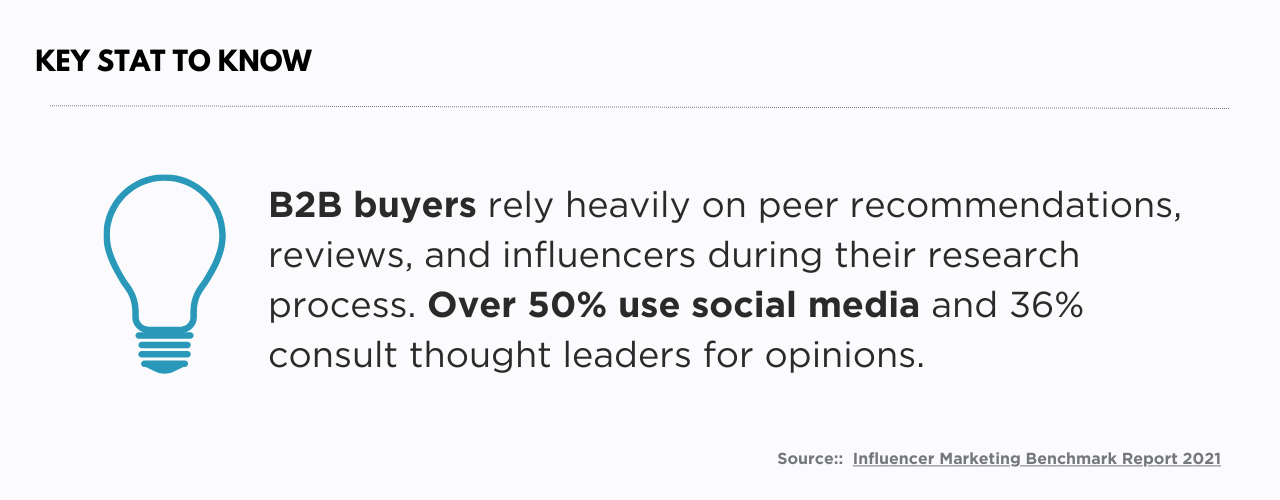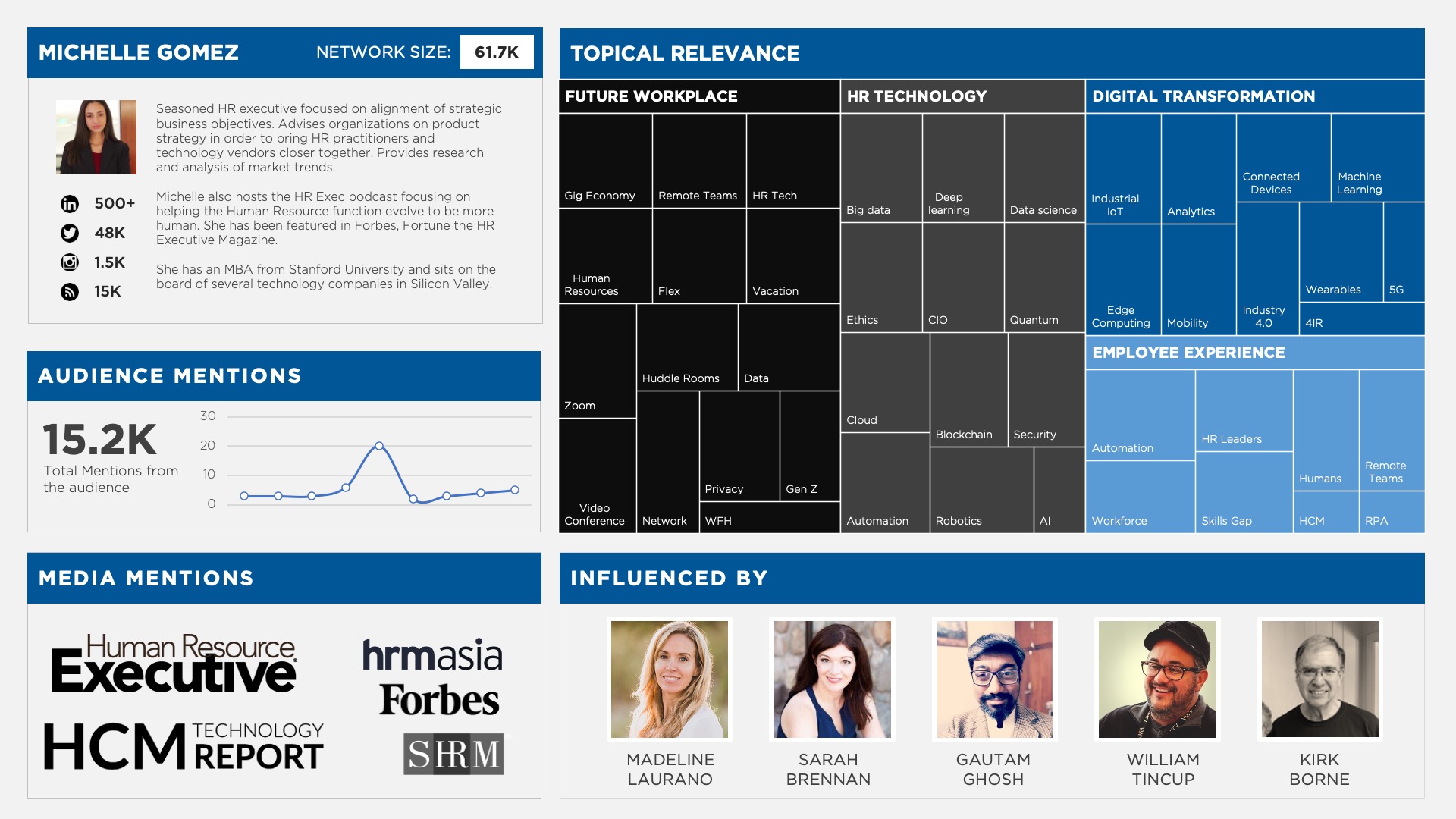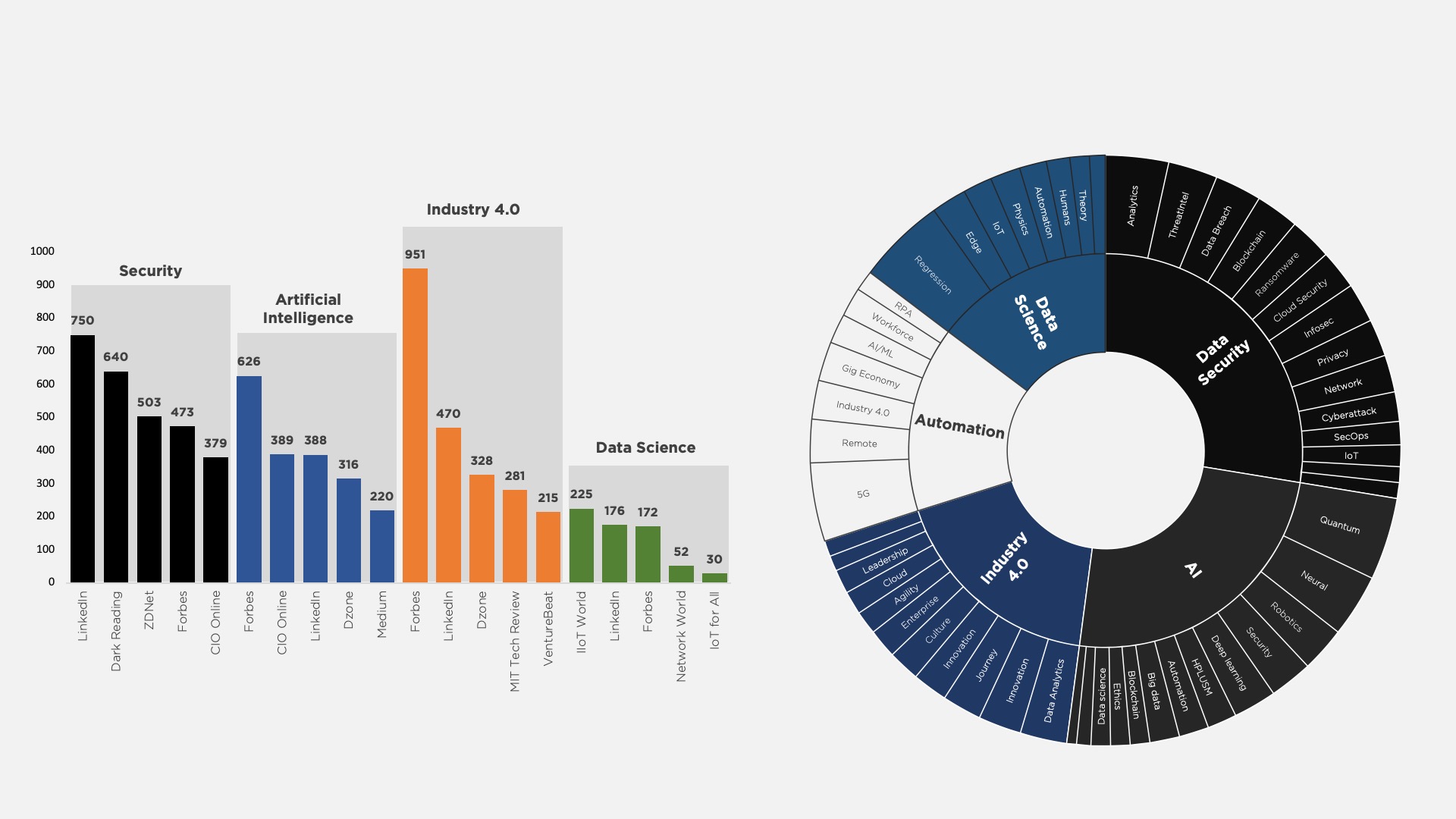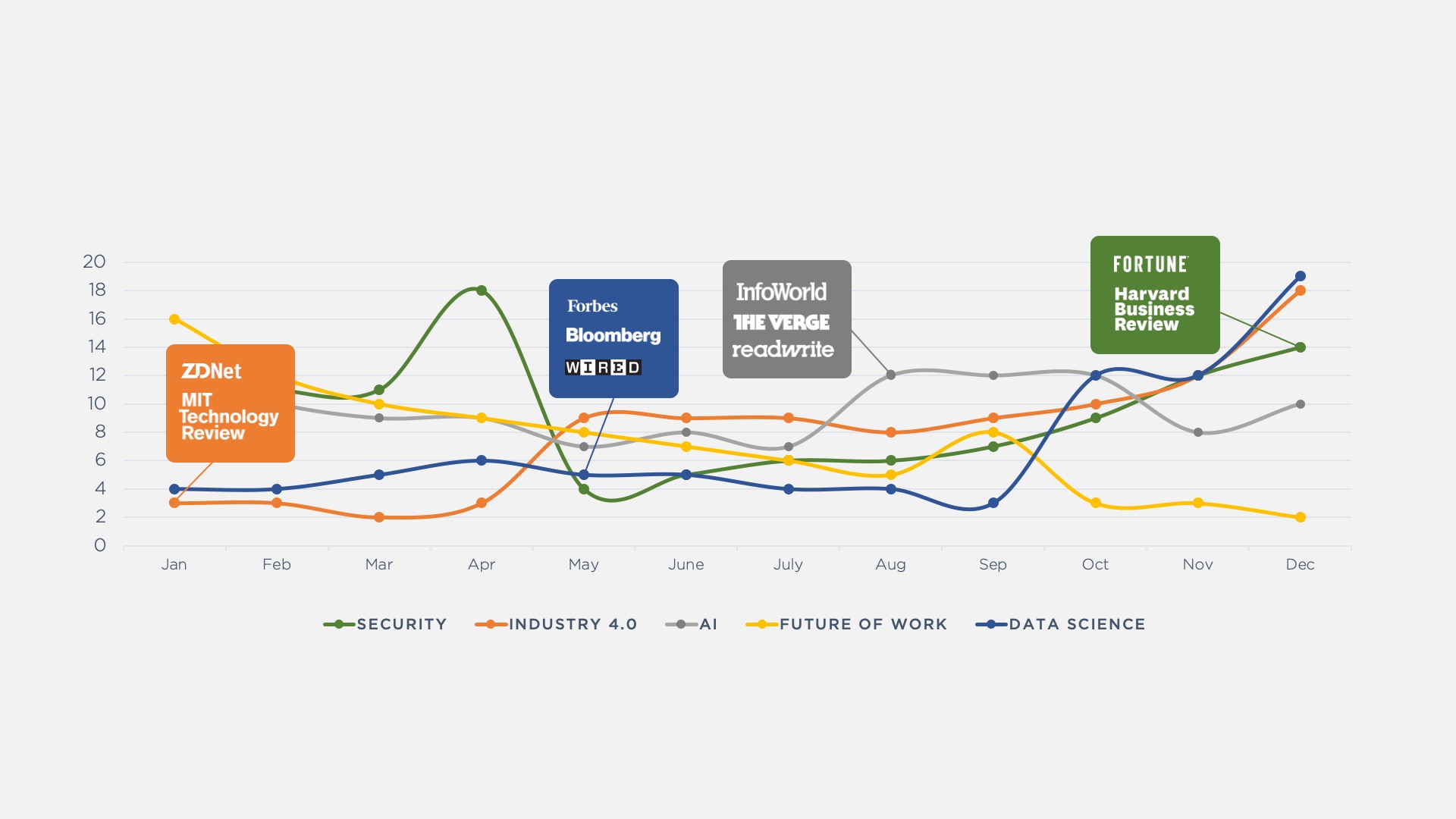
Key Takeaways: B2B Influencer Research 📈 📊
- Influencers are crucial for cutting through the hype: In the dynamic B2B tech environment, influencers and industry analysts are key in guiding buyers by providing objective perspectives. These credible voices are pivotal in shaping buyer perceptions during their research phase, with over 78% of enterprise tech buyers influenced positively by such coverage.
- Value of credible third-party perspectives: Industry influencers, such as subject matter experts and thought leaders, provide insightful evaluations that go beyond basic feature lists. Their real-world implementation experiences and exposure to customer pain points offer in-depth analysis, helping buyers navigate the crowded market with informed decisions.
- An integrated influencer relations strategy is essential: For effective engagement, tech brands must offer influencers comprehensive access to their products and strategic insights. This allows influencers to provide deeper, more meaningful evaluations, influencing buyer decisions early in the research process and enhancing the brand’s competitive visibility and reputation.
- Individual influencer profiling offers targeted insights: Deep analysis of individual influencers, beyond follower counts, reveals their expertise, audience resonance, and ecosystem connections. This helps brands target relevant influencers for specific paid media campaigns, making their endorsements more impactful.
- Group topical analysis for broader awareness strategies: Analyzing entire groups of influencers based on awareness topics or sectors provides a macro view of key themes and media outlets. This approach helps brands align their messaging with current discussions and trends, enabling more effective content creation and promotion.
- Trend analysis for agile, data-driven targeting: Monitoring topic shifts among influencers allows brands to adapt their messaging and outreach strategies to align with current conversations. This ongoing trend analysis ensures that brands remain relevant and effectively engage with their audience through influencer channels.
Understanding the Complex B2B Technology Landscape
The B2B tech landscape is evolving rapidly and almost dizzyingly. Significant innovations in SaaS, cloud computing, artificial intelligence (AI), and data security emerge daily, leading to an increasingly complex and crowded market for B2B technology.
Established tech giants and agile startups rush to bake cutting-edge capabilities like automation, real-time analytics, Generative AI, predictive insights, and machine learning into their platforms. The breakneck speed of bringing new products and features to market feeds off and fuels the tech industry’s boundless imagination and ambition.
Challenges in Differentiation: The speed of new product releases makes it hard for B2B brands to distinguish genuine innovation from mere hype in technology offerings.
However, this relentless innovation cycle also creates profound challenges for B2B tech brands and enterprises looking to leverage these technologies. It becomes challenging to discern true innovation and utility from hype or exaggeration when evaluating the flood of new tools and solutions.
Why B2B Technology Brands Should Engage Influencers
Amidst this complex landscape filled with sky-high promises and potential pitfalls, B2B tech buyers desperately need trustworthy guides who can cut through vendor hype and provide an objective outside-in perspective.
This is why B2B technology brands should actively cultivate relationships with industry analysts and influencers aligned with their market. Their credible voices help shape buyer perceptions during critical research, even before sales contacts engage. Over 78% of enterprise tech buyers report that influencer content helps them shortlist and engage with new tech providers when assessing the crowded landscape.
B2B Influencer Research Helps Buyers Cut Through Hype
Evaluating complex B2B technology solutions requires trusted guidance from those with real-world implementation experience. As explored previously, enterprises rely heavily on analyst and influencer perspectives to inform selection and optimize investments amidst dynamic market conditions.
But what makes explicitly these independent third-party views so uniquely valuable for shaping stakeholder perceptions? And how can tech providers effectively cultivate productive engagements with crucial industry commentators? This next section examines the strategic influence wielded by credible influencer ecosystems.
Influencer Engagement: B2B tech buyers seek trusted guides to navigate the market, making it crucial for brands to partner with industry analysts and influencers.
The Value of Credible Third-Party Perspectives
Among the most valuable curators are industry influencers – third-party subject matter experts, analysts, and thought leaders – whose perspectives shape stakeholder perceptions during research. More narrowly focused than generalist research firms, niche bloggers, speakers, and community figures combine deep expertise with extensive customer exposure.
These front-line vantage points into real-world implementations, underserved pain points, and use case variances make their evaluations exceptionally insightful. Commentary moves beyond simple feature checklists or ROI calculators to explore subtle but profound limitations and caveats hidden beneath sleek vendor messaging.
Such unvarnished outside-in perspectives build essential context around competitive differentiation and best-fit scenarios for buyers navigating crowded markets. Ongoing coverage of emerging acquisition targets, leadership changes, and platform updates further empowers users to optimize their unique objectives amidst dynamic conditions continually.
Credible Third-Party Perspectives: B2B and technology influencers provide valuable insights into real-world tech implementations, offering a more nuanced understanding than broad analyses.
An Integrated Influencer Relations Strategy
To leverage these invaluable intermediaries, tech brands must prioritize transparent engagement beyond traditional press relations. The most effective strategies offer unfettered access to products, executives, and directional guidance.
This enables analysts to look under the hood, probing beyond superficial capabilities to gauge tangible benefits relative to current customer pain points and competitor alternatives. In turn, their commentary reaches wider audiences at the earliest stages of research – shaping shortlists even before sales outreach begins.
Carefully cultivated analyst relationships thus pay both short and long-term dividends in competitive visibility and marketplace reputation. But brands must avoid overly restrictive messaging control or NDAs that could undermine trust. Ultimately, the goal is to facilitate credible third-party validation aligned with, but editorially independent from, internal positioning.
B2B Influencer Research Examples
| Research | Goals | Methods | Deliverables | Additional Info |
|---|---|---|---|---|
| Individual Influencer Profiles | Surface expertise and validate reach/resonance | Follower tracking, content analysis, external mentions tracking | Topical cluster map, media/audience validation stats | Expand beyond simplistic follower numbers to showcase multifaceted impact |
| Group Topical Analysis | Map awareness landscape, identify key outlets | Aggregate content clustering, media outlet mapping | Hot topics overview, media outlet resonance index | Essential context to integrate messaging into conversations |
| Trend Analysis | Track momentum shifts, spot rising/declining topics | Longitudinal clustering, monthly topic tracking | Monthly topic resonance dashboard, adaptable targeting roadmap | Iteratively update outreach/content based on emerging trends |
1. Profiling Individual B2B Influencers

In-depth influencer intelligence requires going far beyond basic profiles to uncover actionable insights. Rather than relying on influencer marketing tools that provide names and audience sizes, the rigorous analysis examines multiple facets of influence – from topical relevance to audience validation to broader ecosystem connections.
Consider this example of an influencer profile for Michelle Gomez, an HR industry thought leader. The snapshot captures key metrics like her extensive follower count across social channels. Additionally, cluster analysis of her content surfaces the topics most prominent in her writing and social shares – highlighting subject matter expertise around future workplace transformation, HR technology, employee experience, and more.
But the profile also includes external validation points. Trade media mentions confirm her wider visibility as an industry commentator. Similarly, audience engagement tracking verifies that she directly influences buyer personas of interest. If self-identified HR leaders actively share or discuss their perspectives, this elevates their value for vendor targeting that audience.
How Brands Can Use This Data
With rich insights on topical expertise and audience resonance, B2B brands can target relevant influencers for awareness campaigns, content amplification efforts, and third-party validation strategies. Cluster analysis spotlights which commentators to prioritize for specific solution areas or emerging tech topics. Meanwhile, concrete evidence of existing audience connections enables more compelling and personalized partnership pitches.
For example, the detailed visibility this data provides into Michelle Gomez’s leadership around HR technology and future workplaces empowers hiring software vendors to tailor guest blog opportunities and conference speaking invites. Her established credibility among those buyer personas makes her endorsements more impactful than general awareness plays.
Likewise, tracking the external validation points over time provides benchmarks to monitor partnership success. As brands supply more tier-one access and guidance, they can track upticks in media references, shared content, and audience mentions as key performance indicators. Doing so quantifies the halo effect and validates further relationship investment to stimulate organic advocacy.
Overall, marketing and PR teams can evolve beyond generalized influencer lists to precisely cultivate the highest-value validators. Combining intimate intelligence with multi-channel amplification unlocks the true strategic potential of industry partnerships.
2. B2B Influencer Research & Topical Analysis

Expanding beyond just individual influencers, analysis can also examine entire groups based on awareness topics or sectors. Mapping where they consume content spotlights key media outlets and coverage angles that resonate. Like persona research, brands can intersect influencer conversations via relevant messaging.
Group Topical Analysis: Analyzing groups of influencers allows brands to identify key topics and preferred media outlets, aiding in the development of targeted content and outreach.
These multifaceted insights enable precision targeting and tiering well beyond one-dimensional follower counts. Combining internal amplification with targeted outreach and access helps brands cultivate and leverage key voices to shape audience perceptions. In an increasingly fragmented media universe, the value lies in identifying influencers and truly understanding their ecosystem footprint through actionable data.
This data tells us what topics, trends, and stories are top of mind for the top 20 influencers and where they go online to consume content.
How Brands Can Use This Data
Examining entire influencer cohorts equips brands with a broader stroke awareness strategy beyond specific individual partnerships. The macro view of key topics, preferred media outlets, and discussion catalysts inform optimum content creation and promotion frameworks to organically intersect community conversations.
For example, mapping a group of 20 leading fintech voices spotlights automation, blockchain innovation, and data ethics as dominant themes. This signifies prime targets for relevant blogs, op-eds, and panel pitches. Likewise, noting concentration around Forbes, TechCrunch, and Substack commentary offers helpful guest posts, brand mentions, and advertising channels.
Such collective intelligence gathering establishes solid messaging foundations. Brands can then funnel insights on specific influencers to sharpen efforts further. If particular voices spark Twitter debates on AI bias, targeted quote responses or data point sharing hastens topical relevancy.
Over time, this multilayered B2B influencer research methodology combining macro trend analysis and micro profile granularity enables fluid activation scaling. As new topics gain momentum or niche commentators rise, existing assets keep pace with shifting tides to catch the conversational wave.
3. Collective B2B Influencer Research & Trends

Consider the same group of 20 leading security influencers. Cluster analysis maps the key topics prominent across their collective social sharing and published perspectives. Comparing month-over-month changes reveals meaningful shifts in situational awareness.
This data indicates that Industry 4.0 has rapidly increased in relevance for these thought leaders over the past year. The umbrella buzzword encompassing automation, IoT, robotics, and more recurs throughout coverage. This likely intersects with growing readership interest in leading-edge technologies.
Trend Analysis for Agile Marketing: Continuous monitoring of influencer discussions and trends helps brands adapt their messaging and strategies to current market interests.
By contrast, dialogue around the future of work transformations has tapered off significantly since January across the group. The downward trend signifies declining attention to this previously prominent topic. For the brand’s marketing innovations in this area, pivoting messaging to align with Industry 4.0 would likely resonate strongly.
This dynamic topical analysis empowers more agile, data-driven targeting rather than outdated assumptions; fresh intelligence spotlights relevant narratives and coverage angles to integrate. Over time, brands can iteratively adapt outreach and amplification to ride rising conversations in the influencer ecosystem.
How Brands Can Use This Data
Ongoing tracking of topics and themes across key influencer cohorts provides an invaluable pulse on momentum shifts. By comparing month-over-month changes in dialogue concentration, brands can rapidly realign messaging frameworks, and content plays to ride new waves of commentary.
Consider an enterprise solution provider marketing AI and automation capabilities for retail analytics. Research spotlights a sharp uptick in attention towards Industry 4.0 innovations among the top voices covering that sector—however, dialogue around more transformational shifts in commerce and work models plateaus.
Armed with these insights, marketing teams would be wise to weave Industry 4.0 terminology, use cases, and stats prominently throughout updated collateral and blogs. Likewise, increased media pitches and op-ed contributions centered on automation and IoT opportunities better match the target audiences‘ shifting focus tracked in the data.
Over time, continued monitoring of rises, declines, and breakout topics minimizes the risk of outdated messaging. Brands equip themselves to adopt awareness building nimbly, seek relevant partnerships, and increase visibility through channels where influential discussions concentrate each quarter.
Wrap-Up Thoughts
As explored through these examples, in-depth B2B influencer research delivers tremendous strategic value for technology brands seeking to cut through noise and connect with stakeholders amidst complex market conditions. Properly contextualized insights empower agile, targeted awareness-building rather than generalized spam.
Specifically, precision tracking of topic trajectories, media habits, and audience engagement signals equips marketers to optimize messaging and partnerships continually. Content resonates when synchronizing with rising conversations in real-time across both marquee commentators and niche voices aligned with buyer interests.
For CMOs and other marketing leaders, leveraging the insights from B2B influencer research is key. It’s not just about identifying influencers but understanding their impact, the topics they discuss, and their audience’s interests. This enables brands to tailor their messaging, align with current market trends, and build lasting, trust-based relationships with both influencers and their target audience. This strategic approach goes beyond superficial metrics, providing a deeper, more actionable understanding of the market.
Likewise, quantified validation metrics prove relationship cultivation impact over time while spotlighting new avenues for organic reach. Ultimately, the quality of intelligence and application potential uncovered far surpasses superficial follower counts or vanity metrics. With multifaceted influencer illumination, the stage is set to programmatically scale visibility through conversations rather than transient, transactional promotions.
The key is committing to the ongoing research rigor rather than sporadic superficial assessments. With sustained monitoring and committed activation, brands inject their perspectives into community dialogue while earning trust as go-to authorities worth referencing amidst dynamic technological transformations.
